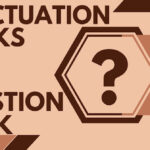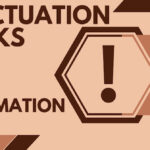Question Mark Punctuation Marks: Unlocking the Secrets of Effective Written Communication
The Importance of Proper Punctuation in Writing
In the world of writing, the importance of proper punctuation cannot be overstated. Punctuation helps clarify meaning, rhythm, and tone in a written work.
It communicates to readers when to pause, when to emphasize certain words or phrases, and when to signal a change in tone or direction.
One such crucial piece of punctuation is the question mark.
The question mark is an essential tool for writers when asking direct questions or expressing doubt or uncertainty about something.
Without this simple punctuation mark, sentences can become confusing and ambiguous.
For example:
“Are you coming with us”
could mean either
“Are you coming with us?”
The placement of a question mark clearly distinguishes between these two meanings.
Brief Explanation of Question Mark Punctuation Marks
Question marks are used at the end of sentences that ask direct questions.
They are often placed where a period would normally go and indicate that the sentence is interrogative.
In addition to their use in forming direct questions, question marks can also signal skepticism or uncertainty on the part of the speaker or writer.
It’s important to note that not all interrogative sentences require a question mark; whether one should be used depends on context and sentence structure.
For example:
“I wonder what time it is” is technically an indirect question but still conveys doubt or uncertainty –
it does not require a question mark at its end because it doesn’t ask directly for information.
Overall, understanding how to use the question mark properly ensures that your writing will convey its intended meaning clearly and effectively while also adhering to standard rules of grammar and usage.
Explanation of Question Mark Punctuation Marks
Definition and Purpose of Question Marks
Question marks are punctuation marks used to indicate a direct question or to express doubt or uncertainty in a statement. They have a distinct curved shape, (?)
In written text, they are placed at the end of sentences that ask for information or express doubt.
The primary purpose of question marks is to signify the presence of an interrogative sentence – that is, one that asks a direct question.
Without the question mark, it can be difficult for readers to distinguish between declarative statements and questions.
Additionally, when used at the end of statements meant to convey uncertainty or doubt, the question mark can establish tone and meaning in writing.
How They Differ from Other Punctuation Marks
While there are several types of punctuation marks used in written language, question marks differ from others in their specific function.
For example
periods (.) are used at the end of declarative statements and exclamation points (!) indicate strong emotion or emphasis.
Question marks also differ from other punctuation marks in their placement within sentences.
Unlike commas or apostrophes which may appear mid-sentence, question marks only appear at the very end of an interrogative sentence.
Another important distinction is that while other punctuation may be optional depending on writer style or communication context, using a question mark is crucial for clarity when asking questions.
Not including one could lead readers to interpret your text incorrectly as non-interrogative.
Uses of Question Mark Punctuation Marks
Indicating a Direct Question in Writing
One of the most common uses of question punctuation marks is to indicate that a direct question has been asked in writing.
Direct questions are typically used to gather information or clarify something that is not fully understood. In writing, direct questions often begin with words like
“who,” “what,” “where,” “when,” “why,” and “how.”
For example,
consider the following sentence:
“What time does the train leave?”
The question mark at the end signals to the reader that this is a direct question being asked by someone seeking information.
Another example would be,
“Is it going to rain tomorrow?”
where the use of a question mark signals that the author is making an inquiry and seeking an answer.
Conveying Uncertainty or Doubt in a Statement
Question marks can also be used to convey uncertainty or doubt in a statement.
This usage indicates that while something may appear true or certain, there is still room for questioning or skepticism.
This can be particularly useful when writing persuasive pieces or presenting an argument where you want readers to consider multiple viewpoints.
For instance,
consider this sentence
: “She claims she saw him leaving the building at 6pm?”
Here, the use of a question mark implies that while she may have claimed it, there’s some uncertainly about whether she actually saw him leave at 6pm.
Similarly, another example could be
“The suspect didn’t have an alibi for Friday night?”.
The use of a question mark indicates uncertainty as to whether there was no alibi available for Friday night.
Signaling a Rhetorical Question
A rhetorical question is one which doesn’t require an answer and serves mainly as emphasis and dramatic effect in creative writing like poetry, plays, and speeches.
The use of a question mark in these situations can signal in writing the author’s intent to leave the question unanswered, or as a powerful way to make a point.
For example,
consider this sentence:
“Why does anyone bother listening to him anymore?”
Here, the use of a question mark signals that it’s rhetorical and that the author is not seeking an answer.
Another example could be
“Who cares what they think?”
where the question mark indicates that no answer is necessary because it’s not really an inquiry about someone’s opinion but just an expression of frustration or annoyance.
Rules for Using Question Mark Punctuation Marks
Placement within a sentence
When using question marks, it is important to follow certain rules regarding their placement within a sentence.
A question mark should always come at the end of a direct question, regardless of whether it is in the middle or at the end of a sentence.
For example:
“What are you doing tonight?” or “Why did you leave so early?”
In cases where the direct question is part of a longer sentence, it may be necessary to use both a question mark and another punctuation mark.
If the statement following the direct question ends with a period or exclamation mark, only one punctuation mark should be used and the stronger one should take precedence.
For example:
“Do you have any plans tonight? I was thinking we could go see a movie.
Alternatively, if the statement following the direct question ends with a comma or semicolon, both marks should be used.
For example: “Can you tell me what time it is? It feels like we’ve been waiting forever.”
Capitalization following the question mark
Another important rule when using question marks is capitalization following them in sentences.
If the sentence continues after the question mark and leads into another independent clause, then capitalize that independent clause’s first letter.
However, if there is only one clause after said punctuation point such as an indirect or embedded quotation then no capitalization needed as usual.
For instance:
“Are we going to watch Netflix tonight?” she asked.
If there are two clauses in total (including two independent clauses), capitalize when appropriate like this:“Are we going to watch Netflix tonight?” She asked me before looking back at her phone.
Overall, understanding these rules will help ensure that your use of question marks is accurate and effective for conveying your intended meaning through writing.
Example Sentences with Question Mark (Punctuation Marks)
Question marks are an essential tool in written communication.
They allow writers to convey direct questions, uncertainty, and rhetorical inquiries.
Below are a few examples of how question mark punctuation marks can be used in various contexts.
1) “What time is the meeting?”
This sentence uses a question mark to indicate a direct question. In this case, the speaker is seeking information about the time of a meeting.
The use of the question mark signals that this sentence requires an answer from the recipient, prompting them to respond with the necessary information.
2) “Are you sure you want to do that?”
In this example, the use of the question mark indicates doubt or uncertainty on behalf of the speaker. This sentence could be interpreted as a warning or suggestion against taking a particular action.
The placement of the question mark at the end emphasizes that this statement requires consideration and thoughtfulness regarding one’s actions.
3) “Why would anyone do such a thing?”
This sentence utilizes a rhetorical question for emphasis. The speaker does not necessarily require an answer but instead uses this inquiry to express their confusion or disbelief about something they’ve observed or heard about.
The use of a question mark in this case signals that it is still grammatically correct and serves its purpose rhetorically.
When used correctly, example sentences like these demonstrate how effective question marks can be in conveying meaning and tone in writing.
Whether indicating direct questions, expressing doubt or uncertainty, or using rhetoric for emphasis, these simple punctuation marks play an essential role in clear and effective communication.
Subtopics on Question Mark
Use in Informal Writing, such as Texting or Social Media Messaging
The use of question marks has become increasingly prevalent in informal writing, especially in the realm of texting and social media messaging. In these contexts, question marks are often used to convey tone, inflection, and intention.
For example,
a simple message like “What’s up?”
can take on a variety of meanings depending on the way it is punctuated.
If there is no question mark at the end of the sentence, it could be interpreted as a greeting or statement.
However, if there is a question mark present, the sentence takes on a more direct and inquisitive tone. Additionally, many people use multiple question marks to convey emphasis or urgency.
For instance,
“What??? Are you serious?” conveys a much stronger emotional reaction than “What? Are you serious?”
In these instances, the use of multiple question marks serves as an indicator of intensity and emotion. Despite its informal nature, proper punctuation still plays an important role in conveying meaning and ensuring clear communication in these contexts.
Use in Academic Writing, including Research Papers and Essays
Contrary to popular belief that punctuation is only necessary for creative writing and informal communication modes like texting or social media messaging; punctuation holds an essential place even during academic writing for research papers or essays.
Proper usage of punctuations ensures that your writing communicates your intended message clearly while maintaining its formality. When incorrectly used however it can lead to confusion on part of both readers and writers alike.
One area where proper punctuation becomes crucial is during academic citations using quotation marks when reproducing text from other sources within their work.
Quote citations provide crucial evidence supporting arguments presented by researchers or students; hence proper quotation placement with respect to punctuation becomes paramount.
while most people associate punctuation with creative writing or informal communication modes like texting, they hold an equally important role in academic writing.
By following proper punctuation rules, researchers and students, enhance the clarity of their work while ensuring that their arguments are not obscured by poorly placed punctuations.
The Origins and Evolution of the Question Mark Symbol
The question mark symbol has a long and fascinating history, dating back to ancient civilizations such as the Greeks and Egyptians.
In these early cultures, questions were often indicated by intonation or special words rather than a specific symbol. However, over time, various symbols were developed to denote questions in written language.
One of the earliest examples of a question mark-like symbol comes from 8th century Spain, where scholars used an inverted semicolon (;) to indicate rhetorical questions. This symbol eventually evolved into the modern-day question mark we know today.
Interestingly, early versions of the question mark looked more like an upside-down tilde (~), with its modern shape only becoming standardized in the 16th century.
The evolution of the question mark symbol also reflects changes in the way we use language and communicate with each other.
As language became more standardized and formalized over time, so too did punctuation marks like the question mark. Today, it is an essential tool for conveying meaning and intent in our writing.
Regional Variations in Usage and Placement
While the basic function of the question mark remains consistent across different languages and regions, there are many variations in how it is used and placed within a sentence.
For example, in Spanish-language writing, both opening (¿) and closing (?) symbols are used to denote a direct question.
In some Asian languages such as Japanese or Chinese, there is no specific symbol for denoting questions at all; instead, context clues such as intonation or particles are used to convey meaning.
In other cases, such as French or Italian writing conventions dictate that a space should be inserted before placing a question mark at the end of a sentence.
These regional differences reflect both linguistic nuances as well as cultural attitudes towards communication and expression. Understanding these variations can help writers craft more effective messages that are tailored to their intended audience.
Conclusion
The question mark punctuation mark is a vital component of written communication that serves to convey inquiry, uncertainty, and emphasis.
Proper use of this mark can make a significant difference in the clarity and tone of a written message.
Understanding the rules for using question marks and being aware of their nuanced meanings is essential for writers who wish to communicate effectively.
Throughout this article, we have discussed the definition and purpose of question marks, as well as their various uses in different contexts.
We explored examples of sentences that require a question mark and highlighted the importance of proper placement and capitalization. Moreover, we touched upon niche subtopics such as informal vs.
academic writing styles, regional variations in usage and placement, and even historical origins.
It is crucial to emphasize that mastery over punctuation marks such as question marks calls for consistency in writing with attention paid to details often overlooked by beginner writers or non-native speakers.
One way to improve one’s understanding is through regular reading or composing practices under scrutiny by an editor who holds high literacy standards.
By taking these steps towards greater language precision, writers can significantly enhance their communication skills, whether at work or personally with friends or family members – thus improving relationships while showcasing respectful communication habits.





3 thoughts on “Question Mark Punctuation”